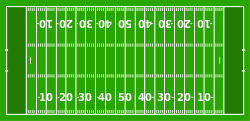Field and players

The numbers on the field indicate the number of yards to the nearest end zone.
American football is played on a field 360 by 160 feet (120.0 by 53.3 yards; 109.7 by 48.8 meters). The longer boundary lines are sidelines, while the shorter boundary lines are end lines. Sidelines and end lines are out of bounds. Near each end of the field is a goal line; they are 100 yards (91.4 m) apart. A scoring area called an end zone extends 10 yards (9.1 m) beyond each goal line to each end line. The end zone includes the goal line but not the end line. While the playing field is effectively flat, it is common for a field to be built with a slight crown with the middle of the field higher than the sides to allow water to drain from the field.
Yard lines cross the field every 5 yards (4.6 m), and are numbered every 10 yards from each goal line to the 50-yard line, or midfield (similar to a typical rugby field). Two rows of short lines, known as inbound s lines or hash marks, run at 1-yard (91.4 cm) intervals perpendicular to the sidelines near the middle of the field. All plays start with the ball on or between the hash marks. Because of the arrangement of the lines, the field is occasionally referred to as a gridiron in a reference to the cooking grill with a similar pattern of lines.
At the back of each end zone are two goalposts (also called uprights) connected by a crossbar 10 feet (3.05 m) from the ground. For high skill levels, the posts are 18 feet 6 inches (5.64 m) apart. For lower skill levels, these are widened to 23 feet 4 inches (7.11 m).
Each team has 11 players on the field at a time. Usually there are many more players off the field (an NFL team has a limit of 53 players on their roster, all of which can be dressed for a game). However, teams may substitute for any or all of their players during the breaks between plays. As a result, players have very specialized roles and are divided into three separate units such as the offence, the defense and the special team. It is rare for all team members to participate in a given game, as some roles have little utility beyond that of an injury substitute.








